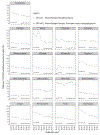Using a severity threshold to improve occupational injury surveillance: Assessment of a severe traumatic injury-based occupational health indicator across the International Classification of Diseases lexicon transition
- PMID: 37850904
- PMCID: PMC11342867
- DOI: 10.1002/ajim.23545
Using a severity threshold to improve occupational injury surveillance: Assessment of a severe traumatic injury-based occupational health indicator across the International Classification of Diseases lexicon transition
Abstract
Background: Traumatic injury is a leading cause of death and disability among US workers. Severe injuries are less subject to systematic ascertainment bias related to factors such as reporting barriers, inpatient admission criteria, and workers' compensation coverage. A state-based occupational health indicator (OHI #22) was initiated in 2012 to track work-related severe traumatic injury hospitalizations. After 2015, OHI #22 was reformulated to account for the transition from the International Classification of Diseases, 9th Revision, Clinical Modification (ICD-9-CM) to ICD-10-CM. This study describes rates and trends in OHI #22, alongside corresponding metrics for all work-related hospitalizations.
Methods: Seventeen states used hospital discharge data to calculate estimates for calendar years 2012-2019. State-panel fixed-effects regression was used to model linear trends in annual work-related hospitalization rates, OHI #22 rates, and the proportion of work-related hospitalizations resulting from severe injuries. Models included calendar year and pre- to post-ICD-10-CM transition.
Results: Work-related hospitalization rates showed a decreasing monotonic trend, with no significant change associated with the ICD-10-CM transition. In contrast, OHI #22 rates showed a monotonic increasing trend from 2012 to 2014, then a significant 50% drop, returning to a near-monotonic increasing trend from 2016 to 2019. On average, OHI #22 accounted for 12.9% of work-related hospitalizations before the ICD-10-CM transition, versus 9.1% post-transition.
Conclusions: Although hospital discharge data suggest decreasing work-related hospitalizations over time, work-related severe traumatic injury hospitalizations are apparently increasing. OHI #22 contributes meaningfully to state occupational health surveillance efforts by reducing the impact of factors that differentially obscure minor injuries; however, OHI #22 trend estimates must account for the ICD-10-CM transition-associated structural break in 2015.
Keywords: International Classification of Diseases; hospital discharge data; injury surveillance; occupational injuries; trauma severity indices; workers' compensation.
© 2023 Wiley Periodicals LLC.
Conflict of interest statement
CONFLICT OF INTEREST STATEMENT
The authors declare no conflicts of interest.
DISCLOSURE BY AJIM EDITOR OF RECORD
John Meyer declares that he has no conflict of interest in the review and publication decision regarding this article.
Figures



Similar articles
-
Improving occupational injury surveillance by using a severity threshold: development of a new occupational health indicator.Inj Prev. 2016 Jun;22(3):195-201. doi: 10.1136/injuryprev-2015-041807. Epub 2015 Dec 10. Inj Prev. 2016. PMID: 26658981
-
Using injury severity to improve occupational injury trend estimates.Am J Ind Med. 2014 Aug;57(8):928-39. doi: 10.1002/ajim.22329. Epub 2014 May 8. Am J Ind Med. 2014. PMID: 24811970
-
Clinical diagnosis groups developed to bridge the ICD-9-CM to ICD-10-CM coding transition and monitor trends in workers' compensation claims - Ohio, 2011-2018.J Safety Res. 2025 Feb;92:408-419. doi: 10.1016/j.jsr.2024.12.007. Epub 2024 Dec 30. J Safety Res. 2025. PMID: 39986860
-
A New Method to Classify Injury Severity by Diagnosis: Validation Using Workers' Compensation and Trauma Registry Data.J Occup Rehabil. 2015 Dec;25(4):742-51. doi: 10.1007/s10926-015-9582-5. J Occup Rehabil. 2015. PMID: 25900409 Free PMC article.
-
Underreporting of workers' injuries or illnesses and contributing factors: a systematic review.BMC Public Health. 2023 Mar 24;23(1):558. doi: 10.1186/s12889-023-15487-0. BMC Public Health. 2023. PMID: 36959647 Free PMC article.
References
-
- National Institute for Occupational Safety and Health. Workplace safety and health topics: traumatic occupational injuries. 2022. Accessed January 17, 2023. http://www.cdc.gov/niosh/injury/
-
- Leigh JP. Occupational injury and illness in the United States. Estimates of costs, morbidity, and mortality. Arch Intern Med. 1997;157:1557–1568. - PubMed
-
- Miller TR, Galbraith M. Estimating the costs of occupational injury in the United States. Accid Anal Prev. 1995;27:741–747. - PubMed
-
- Azaroff LS, Lax MB, Levenstein C, Wegman DH. Wounding the messenger: the new economy makes occupational health indicators too good to be true. Int J Health Serv. 2004;34:271–303. - PubMed
MeSH terms
Grants and funding
LinkOut - more resources
Full Text Sources
Medical

